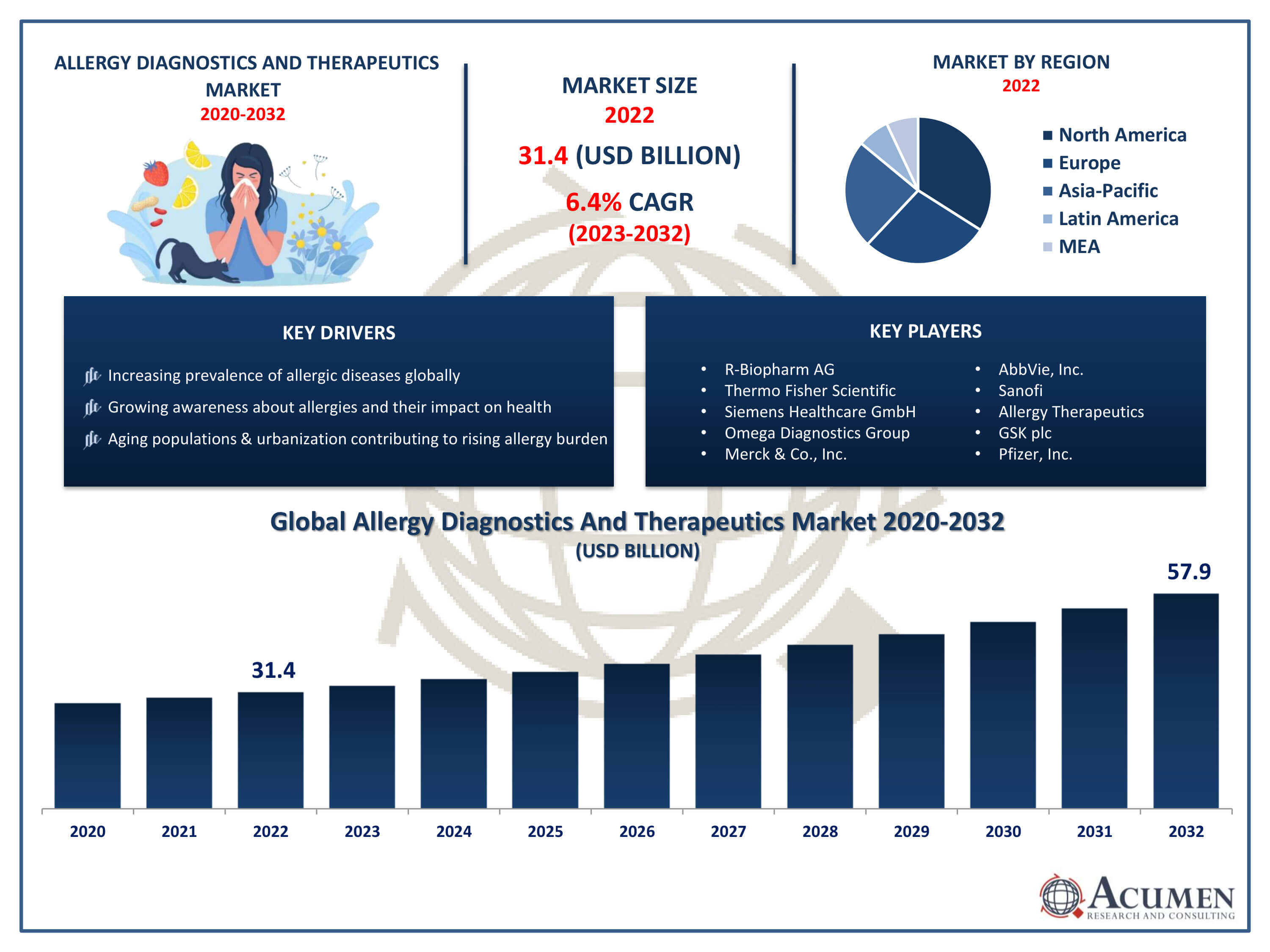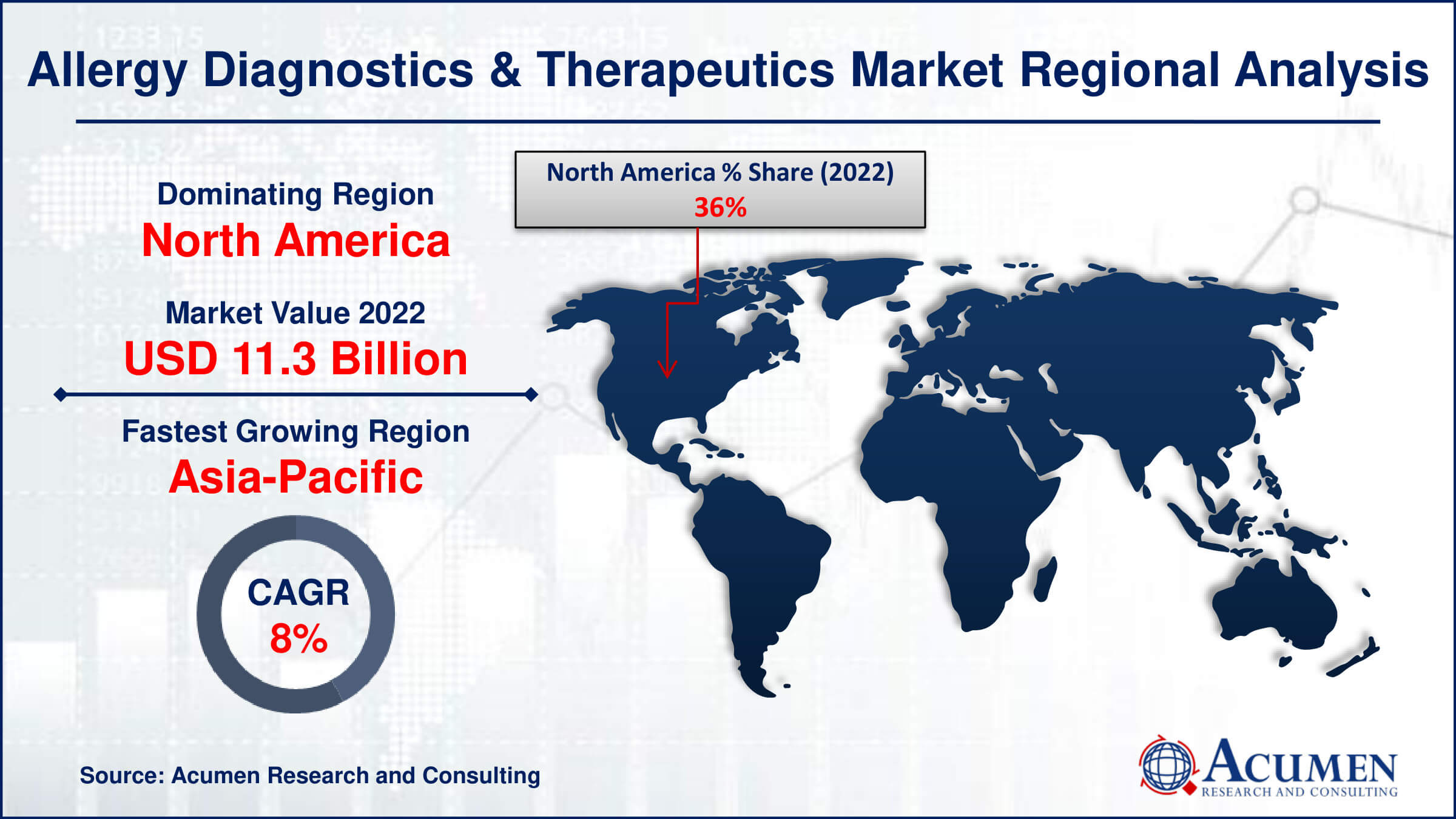December 2022
Allergy Diagnostics and Therapeutics Market Size was USD 31.4 billion in 2022. It is anticipated to reach USD 57.9 billion by 2032, with a projected compound annual growth rate (CAGR) of 6.4% from 2023 to 2032.
The Allergy Diagnostics and Therapeutics Market Size accounted for USD 31.4 Billion in 2022 and is projected to achieve a market size of USD 57.9 Billion by 2032 growing at a CAGR of 6.4% from 2023 to 2032.
Allergy Diagnostics and Therapeutics Market Key Highlights
 Allergy diagnostics and therapeutics encompass a range of techniques and treatments aimed at identifying and managing allergies, which occur when the immune system reacts abnormally to substances that are typically harmless to most people. Diagnostic methods include skin tests, blood tests, and provocation tests to identify specific allergens triggering an individual's allergic reactions. Therapeutic approaches involve allergen avoidance, pharmacotherapy such as antihistamines and corticosteroids, allergen immunotherapy (AIT) to desensitize the immune system, and emerging biologic treatments targeting specific immune pathways.
Allergy diagnostics and therapeutics encompass a range of techniques and treatments aimed at identifying and managing allergies, which occur when the immune system reacts abnormally to substances that are typically harmless to most people. Diagnostic methods include skin tests, blood tests, and provocation tests to identify specific allergens triggering an individual's allergic reactions. Therapeutic approaches involve allergen avoidance, pharmacotherapy such as antihistamines and corticosteroids, allergen immunotherapy (AIT) to desensitize the immune system, and emerging biologic treatments targeting specific immune pathways.
In recent years, the allergy diagnostics and therapeutics market has experienced substantial growth globally. This growth can be attributed to several factors, including the increasing prevalence of allergic diseases such as asthma, allergic rhinitis, and food allergies, which has driven demand for more accurate diagnostic tools and effective treatments. Additionally, advancements in technology have led to the development of more precise and convenient diagnostic tests, as well as novel therapeutic approaches. Moreover, rising awareness about allergies and their impact on quality of life has spurred greater investment in research and development within the field, leading to the introduction of innovative products and therapies into the market.
Global Allergy Diagnostics and Therapeutics Market Trends
Market Drivers
Market Restraints
Market Opportunities
Allergy Diagnostics and Therapeutics Market Report Coverage
| Market | Allergy Diagnostics and Therapeutics Market |
| Allergy Diagnostics and Therapeutics Market Size 2022 | USD 31.4 Billion |
| Allergy Diagnostics and Therapeutics Market Forecast 2032 | USD 57.9 Billion |
| Allergy Diagnostics and Therapeutics Market CAGR During 2023 - 2032 | 6.4% |
| Allergy Diagnostics and Therapeutics Market Analysis Period | 2020 - 2032 |
| Allergy Diagnostics and Therapeutics Market Base Year |
2022 |
| Allergy Diagnostics and Therapeutics Market Forecast Data | 2023 - 2032 |
| Segments Covered | By Product, By Allergen Type, By Drug Class, By Test, By End-user, And By Geography |
| Regional Scope | North America, Europe, Asia Pacific, Latin America, and Middle East & Africa |
| Key Companies Profiled | R-Biopharm AG, Sun Pharmaceutical Industries Ltd, Thermo Fisher Scientific, Inc., Siemens Healthcare GmbH, Lincoln Diagnostics, Inc., Omega Diagnostics Group PLC, Merck & Co., Inc., AbbVie, Inc., Sanofi, Allergy Therapeutics, GSK plc, Pfizer, Inc., F. Hoffmann-La Roche Ltd., and Teva Pharmaceutical Industries Ltd. |
| Report Coverage |
Market Trends, Drivers, Restraints, Competitive Analysis, Player Profiling, Covid-19 Analysis, Regulation Analysis |
Allergies occur when the immune system misinterprets innocuous elements as dangers, such as dust mites, pollen, particular foods, or animal dander. A multimodal approach involving physical exams, specialized diagnostics, and clinical histories is necessary to diagnose these responses. These procedures, which are intended to identify the precise allergens causing the responses, include provocation tests, skin prick tests, and blood testing that assesses certain antibodies. Many therapy approaches can be used to control symptoms and improve quality of life if the offending allergens have been identified. Medications such as antihistamines, corticosteroids, and decongestants to ease symptoms, as well as allergen immunotherapy (AIT), are commonly used as treatments. AIT functions by progressively desensitizing the body over time to particular allergens. Furthermore, novel biologic medicines are being developed that specifically target immunological pathways linked to allergic reactions, providing more accurate and efficient therapy choices for specific allergy types.
Numerous important factors have contributed to the market's spectacular expansion for allergy diagnostics and therapeutics. The most prominent of them is the growth of allergy disorders worldwide. Asthma, allergic rhinitis, and atopic dermatitis have become more common due to changing environmental factors, changing lifestyle choices, and rising urbanization. This increase has therefore raised demand for more advanced diagnostic equipment and successful therapies. In this discipline, technological breakthroughs have revolutionized treatment approaches and led to the creation of more precise and effective diagnostic techniques. These include novel biologic medicines that target certain immune pathways, sophisticated imaging modalities, and molecular diagnostics. These developments have expanded the toolkit of choices for identifying and managing allergies.
The World Health Organization (WHO) reported in January 2023 that 1 in 4 children and 1 in 3 adults in the United States suffer from seasonal allergies. In addition, food allergies affect around 6% of American children and adults, with black, Asian, and Hispanic people having the highest frequency. Similarly, statistics from the Asthma and Allergy Foundation of America in 2021 showed that seasonal allergic rhinitis affected over 81 million Americans, with a prevalence of 19% in children and 26% in adults.
Allergy Diagnostics and Therapeutics Market Segmentation
The global allergy diagnostics and therapeutics market segmentation is based on product, allergen type, drug class, test, end-user, and geography.
Allergy Diagnostics and Therapeutics Market By Product
According to allergy diagnostics and therapeutics industry analysis, the consumables category topped the market rankings in 2022. The increasing demand for allergy testing kits and their necessary chemicals was a major contributing factor in this. With the prevalence of allergic disorders rising globally, there is a greater need than ever for instruments that can rapidly and precisely identify the cause of a patient's symptoms. The need for allergy testing kits has increased dramatically as a result. There are several kinds of these kits available, including molecular diagnostic assays, blood tests, and skin prick tests. However, they are all similar in that, in order to function, they require consumables such as reagents, control materials, and test cartridges.
Allergy Diagnostics and Therapeutics Market By Allergen Type
In 2022, the inhaled segment was the dominant force in the market and it is expected to grow over the allergy diagnostics and therapeutics industry forecast period. This was largely fueled by the rising prevalence of respiratory allergies such as asthma and allergic rhinitis. These conditions often require treatment with inhaled medications like corticosteroids, bronchodilators, and antihistamines, administered through inhalers or nebulizers. As the global burden of respiratory allergies continues to climb, there's a growing demand for effective inhaled therapies, which has significantly expanded this market segment. Additionally, advancements in inhalation technology have been instrumental in propelling the growth of the inhaled segment. Innovations in inhaler design, formulation development, and drug delivery systems have resulted in the creation of more efficient and user-friendly inhalation devices.
Allergy Diagnostics and Therapeutics Market By Drug Class
The market projection for allergy diagnostics and treatments indicates that the antihistamines category is anticipated to have notable expansion in the next years. The rising incidence of allergic conditions such urticaria, allergic conjunctivitis, and allergic rhinitis is one of the main causes. Since histamine is a major mediator of allergic responses, antihistamines are frequently used to treat symptoms including itching, sneezing, runny nose, and hives. The market for antihistamines is expanding due to the rising need for effective symptomatic relief brought on by the rising worldwide burden of allergic illnesses. Furthermore, the antihistamine market has expanded as a result of developments in formulation technologies and medication development.
Allergy Diagnostics and Therapeutics Market By Test
According to the test, there will be substantial increase in the in vivo test market in the allergy diagnostics and therapeutics market forecast period. in vivo testing, which exposes patients to allergens directly in order to monitor allergic reactions, is still a vital part of diagnosing and treating allergies. Common in vivo testing techniques used to determine which allergens cause patients' allergic responses include skin prick testing, intradermal testing, and patch testing. The need for precise and effective diagnostic tools is increasing due to the rising global frequency of allergy illnesses, which is fueling the in vivo test market's growth. Furthermore, the development of in vivo testing methods and technologies has aided in the expansion of this market sector.
Allergy Diagnostics and Therapeutics Market By End-user
The diagnostics labs industry has grown significantly in terms of end customers in recent years. By offering specialized testing services including blood tests, skin prick tests, and allergy panels to identify particular allergens causing allergic responses in patients, diagnostics laboratories play a key role in allergy diagnosis. This market sector is expanding as a result of the rising need for precise and effective diagnostic tools brought on by the increased incidence of allergy illnesses throughout the world. Diagnostic laboratories serve the requirements of both patients and healthcare professionals by providing a centralised and all-inclusive approach to allergy testing. Furthermore, automation and technological developments have aided in the expansion of the diagnostic lab market.
Allergy Diagnostics and Therapeutics Market Regional Outlook
North America
Europe
Asia-Pacific
Latin America
The Middle East & Africa

Allergy Diagnostics and Therapeutics Market Regional Analysis
In terms of Allergy Diagnostics and Therapeutics market analysis, North America is the industry leader. Its main advantages are its sophisticated healthcare infrastructure, its active R&D, and the high degree of awareness among the general public and healthcare professionals. Modern diagnostic methods in the area's well-established network of medical institutions and laboratories allow for prompt and precise detection of allergy disorders. Leading biotech and pharmaceutical firms at the forefront of the development of allergy treatments are also based in North America. This promotes creativity and the launch of cutting-edge therapeutic alternatives. Moreover, North America has a very high frequency of allergic illnesses, including food allergies, allergic rhinitis, and asthma, as compared to other regions, which helps explain the region's market dominance. An rising number of people in the area are experiencing allergies due to a combination of genetic predisposition, dietary changes, and environmental pollutants.
Increased funding has been allocated to allergy research, diagnostic procedures, and treatment strategies as a result of the high illness burden. North America's stance as the market leader for allergy management solutions is further cemented by the region's strong regulatory frameworks and reimbursement policies, which encourage the use of cutting-edge allergy diagnostics and therapies.
To realize its full potential in the area, Siemens Healthiness, for example, separated Asia Pacific into two regions (China and the rest of Asia Pacific) in October 2022.
Allergy Diagnostics and Therapeutics Market Player
Some of the top allergy diagnostics and therapeutics market companies offered in the professional report include R-Biopharm AG, Sun Pharmaceutical Industries Ltd, Thermo Fisher Scientific, Inc., Siemens Healthcare GmbH, Lincoln Diagnostics, Inc., Omega Diagnostics Group PLC, Merck & Co., Inc., AbbVie, Inc., Sanofi, Allergy Therapeutics, GSK plc, Pfizer, Inc., F. Hoffmann-La Roche Ltd., and Teva Pharmaceutical Industries Ltd.
Looking for discounts, bulk pricing, or custom solutions? Contact us today at sales@acumenresearchandconsulting.com
December 2022
August 2022
May 2023
March 2022